Panel 1
Filippo D'Ascola, Paola La Valle, Daniela Paganelli, Raffaele Proietti, Marina Pulcini, Laura Sinapi, Benedetta Trabucco
Physical loss defines the surface area of the seabed lost due to permanent modifications of the substrate and/or seabed morphology induced by anthropogenic activities and/or works, such as coastal defense works, port infrastructures, cables and pipelines, etc. It contributes to defining the level of seabed integrity, as defined under the Marine Strategy Framework Directive (2008/56/EC) and Decision (EU) 2017/848; the Directive is based on an integrated approach and aims for Member States to achieve good environmental status (GES) for their marine waters. Physical loss is calculated for the three Marine Reporting Units (MRUs) under Italian jurisdiction: "Adriatic Sea," "Ionian Sea and Central Mediterranean," and "Western Mediterranean Sea." For the initial population of the "physical loss" indicator, data updated to 2021 are used, i.e., the most recent available data for each type of work; these data will constitute the baseline for future populations. The physical loss indicator allows evaluating both the total extent of the studied phenomenon and the incidence of different types of works and/or activities on the total physical loss; it also assesses the incidence and distribution of physical loss in relation to different habitat types (Broad Habitat Types and Other Habitat Types sensu MSFD) present in Italian seas.
Physical loss quantifies the extent of seabed areas affected by permanent modifications due to alterations in morphology and/or substrate nature, attributable to anthropogenic activities and/or works, such as: coastal defense works, port infrastructures, cables and pipelines, offshore platforms, wind farms, wells for hydrocarbon extraction and exploration (hereafter wells), regasification terminals, and wrecks. It is calculated across the entire national territory, with specific reference to the three Marine Reporting Units (MRUs) under Italian jurisdiction: "Adriatic Sea," "Ionian Sea and Central Mediterranean," and "Western Mediterranean Sea." The calculation of physical loss is performed using the actual surface area for coastal defense works and infrastructures; in all other cases, the footprint is represented, defined based on specific buffers (Foden et al., 2011; Paganelli et al., 2017; HELCOM, 2018). The data are updated to 2021; specifically, for each category of work, the most recent available data were considered: for ports and coastal defense works, the data are updated to 2018; for cables, pipelines, and wrecks, the data, provided by IIM, are updated to 2020; while for the remaining cases, the data are updated to 2021. The extent of physical loss by habitat type is also calculated, using the Broad Habitat Types (BHT) sensu MSFD; for the Other Habitat Types (OHT), the extent of physical loss on the Posidonia beds habitat, derived from the EUNIS level 3 classification (Evans et al., 2014; 2016), was specifically calculated.
To quantify the extent of seabed lost due to anthropogenic activities and/or works and to describe the contribution provided by type of activity and habitat type; to assess the impact these activities have on the seabed and contribute to the assessment of seabed integrity under Descriptor 6 sensu MSFD. The indicator will allow evaluating the changes over time in physical loss, both total and by habitat type, in the three MRUs present in Italian territory.
The main national and European regulatory references related to the physical loss indicator are: Marine Strategy Framework Directive 2008/56/EC, transposed in Italy with Legislative Decree 190/2010, and Decision (EU) 2017/848; Ministerial Decree of the Ministry of Environment, Land and Sea Protection 15/02/2019 "Update of the determination of good environmental status of marine waters and definition of environmental targets." The calculation of physical loss falls among the necessary fulfillments for the implementation of the Marine Strategy Directive. The Directive requires that, to prevent degradation and restore damaged marine ecosystems, each country must implement the necessary measures to achieve (or maintain) good environmental status (GES), i.e., a status capable of preserving the ecological diversity and vitality of clean, healthy, and productive seas and oceans, as well as the sustainable use of the marine environment. GES is determined based on 11 qualitative descriptors of the marine environment that refer to multiple aspects of marine ecosystems, including biodiversity, chemical contamination, and food webs. In this context, physical loss is one of the pressures that contribute to defining seabed integrity, as defined in Descriptor 6 (one of the aforementioned 11 descriptors).
Panel 2
Evans D., Condé S. & Royo Gelabert E. (2014). Crosswalks between European marinehabitat typologies - A contribution to the MAES marine pilot. ETC/BD report for the EEA. Evans D., Aish A., Boon, A., Condé, S., Connor, D., Gelabert, E. Michez, N., Parry, M., Richard, D., Salvati, E. & Tunesi, L., 2016. Revising the marine section of the EUNIS Habitat classification - Report of a workshop held at the European Topic Centre on Biological Diversity, 12 & 13 May 2016. ETC/BD report to the EEA. Foden J., Rogers S.I. and Jones A.P. (2011) Human pressures on UK seabed habitats: a cumulative impact assessment. Marine Ecology Progress Series 428, 33–47. HELCOM (2018): Thematic assessment of cumulative impacts on the Baltic Sea 2011-2016. Baltic Sea Environment Proceedings No. 159. Available at: http://www.helcom.fi/baltic-sea-trends/holistic-assessm Paganelli D., P. La Valle, M. Pulcini, R. Proietti, L. Nicoletti, B. La Porta, L. Lattanzi, A. Pazzini, M. Targusi and M. Gabellini (2017). Towards an evaluation of physical loss pressure in the Italian seas for the implementation of the marine strategy framework directive. Journal of the Marine Biological Association of the United Kingdom1-9. Marine Biological Association of the United Kingdom, 2017 doi:10.1017/S0025315417000911.
- absence of evaluation criteria; - different sizes and shapes of the reference geographical areas (MRU).
Data quality assessment
MiTE (Ministry of Ecological Transition), MSE (Ministry of Economic Development
Accessibility varies depending on the data type: - BHT and OHT (EUNIS, level 3): https://www.emodnet-seabedhabitats.eu/; https://www.eea.europa.eu/data-and-maps/data/eunis-habitat-classification - defense works and port infrastructure: ISPRA elaborations (digitalization in GIS environment) on the e-mail.
National (I)
Data updated to 2021. For each category of work, the most recent available data were considered. For ports and coastal defense works: data updated to December 2018; for cables, pipelines, and wrecks: data provided by IIM, updated to December 2020; for other types of works: data updated to December 2021.
Indicator assessment
The physical loss indicator is calculated, for each MRU, as the algebraic sum of the physical loss measured for each anthropogenic activity; physical loss by habitat type is also calculated – BHT OHT, EUSeaMap 2021, EUNIS level 3. The indicator is expressed in km² (corresponding to the extent of lost seabed). Physical loss is represented, for each MRU, as:
- physical loss (in km²)
- physical loss by type of activity (in %)
- physical loss by habitat type (km²)
- for each habitat type, physical loss by type of activity (%).
Not definable because evaluation criteria are missing. In Italian seas, physical loss presents absolute values between 15-16 km² for the MRU Ionian Sea and Central Mediterranean and the Adriatic Sea, while it reaches values of about 46 km² in the MRU Western Mediterranean. In percentage terms, the values, referring to the extent of physical loss compared to that of the reference MRU, vary from 0.007% observed in the MRU Ionian Sea and Central Mediterranean, to 0.015% in the MRU Western Mediterranean, to 0.026% in the MRU Adriatic Sea. In all MRUs, physical loss is mainly associated with the presence of ports. This is followed by contributions from cables and defense works in the MRU Ionian Sea and Central Mediterranean, Western Mediterranean, and defense works and pipelines in the MRU Adriatic Sea. Other types of works have consistently very low values.
It is not possible to describe/evaluate the trend as this is the first population of the indicator.

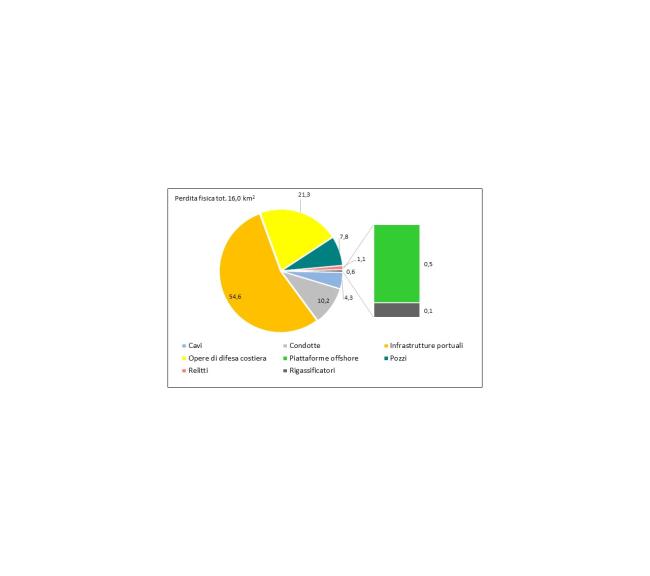
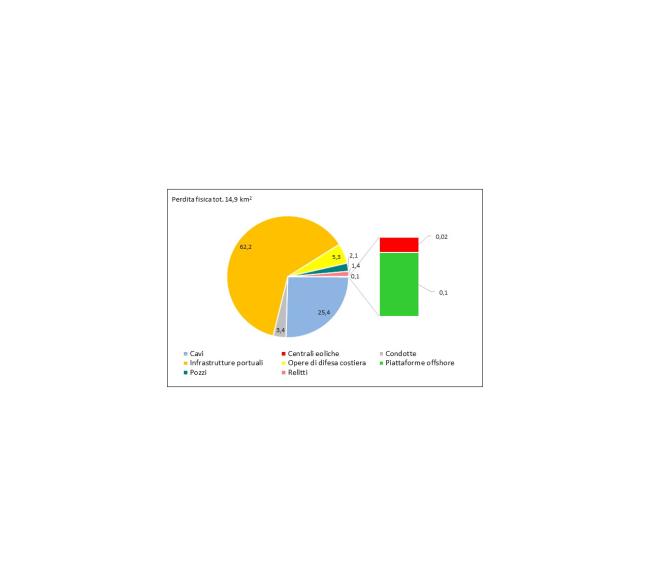
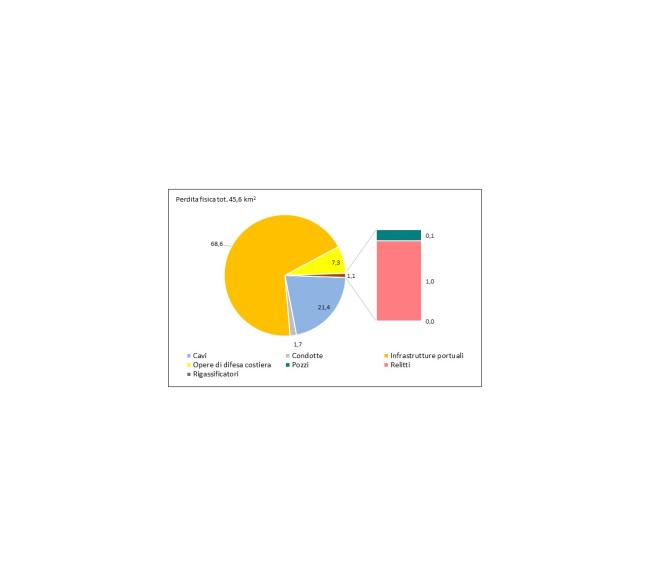
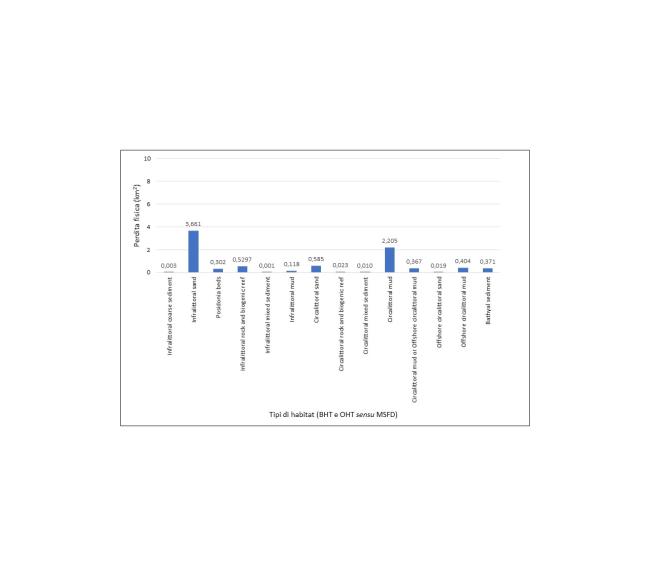
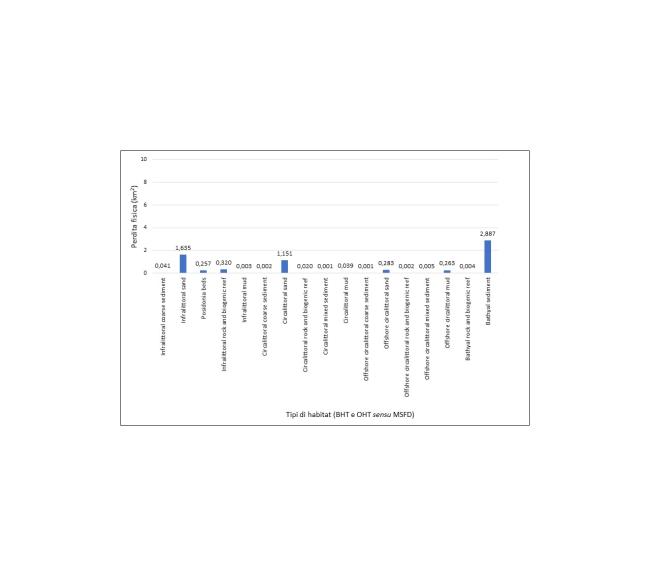
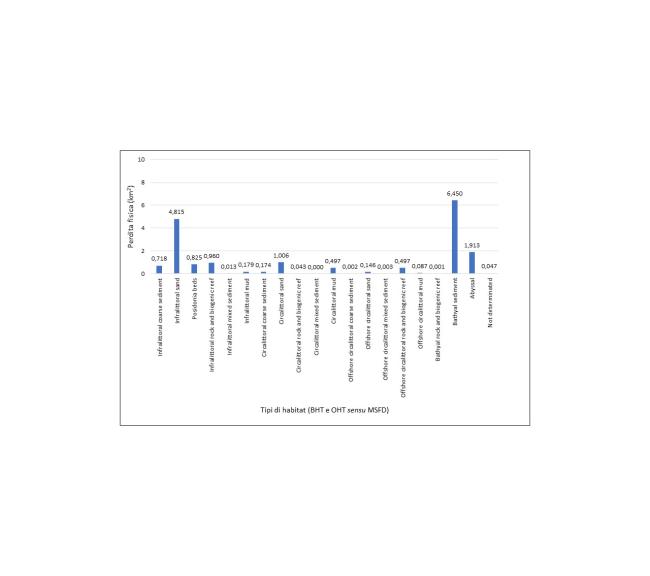
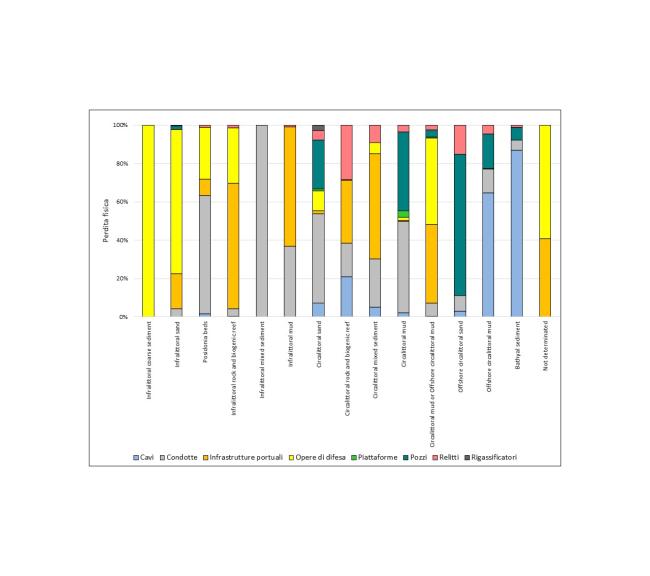
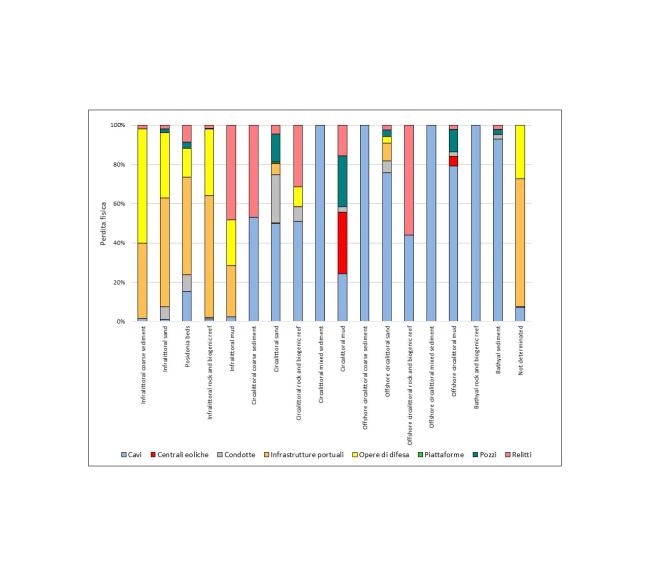
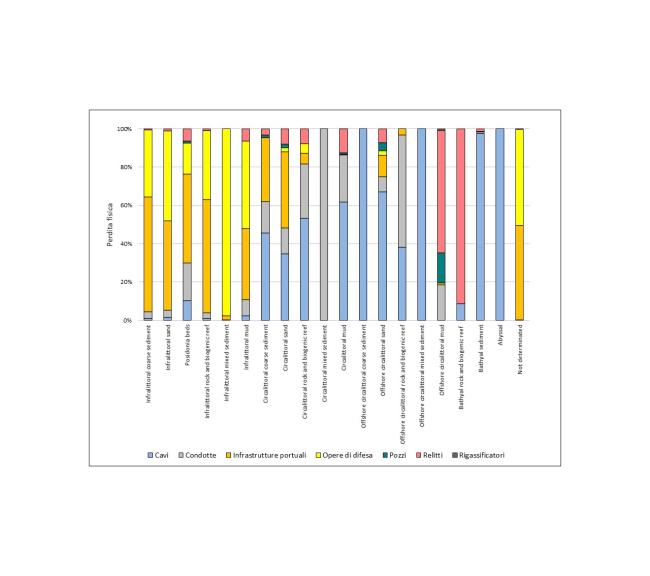
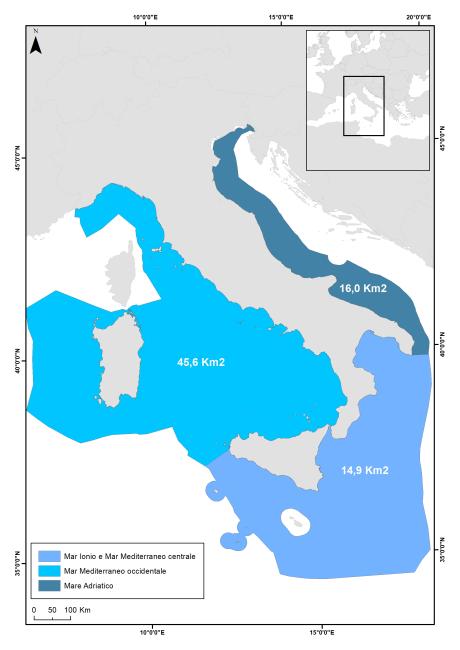
In Italian seas, physical loss presents values between 15-16 km², detected respectively in the MRU Ionian Sea and Central Mediterranean and in the MRU Adriatic Sea (which measure 218,378 km² and 62,141 km² in extent, respectively) and the approximately 46 km² observed in the MRU Western Mediterranean Sea with an extent of 310,712 km² (Figure 1). It is generated by the following categories of works: cables, pipelines, port infrastructures, coastal defense works, offshore platforms and wells, wrecks, regasification terminals, wind farms (Figures 2a, 2b, and 2c). Directly related to the nature and characteristics of the works that generate it, physical loss presents a more uniform distribution near the coast, becoming irregular and sporadic as it moves offshore. In all MRUs, the category of work that most significantly impacts physical loss is port infrastructures, with values ranging from 54.6% (MRU Adriatic Sea) to 68.6% of total physical loss (MRU Western Mediterranean Sea). In the MRU Adriatic Sea, about 86% of the total physical loss is due to the combination of port infrastructures, coastal defense works, and pipelines, while in the other two MRUs (Ionian Sea and Central Mediterranean and Western Mediterranean Sea), port infrastructures and cables contribute respectively to 87.6% and 90% of the total physical loss. Specifically, Figure 2a (MRU Adriatic Sea) shows that the total physical loss, which amounts to 16.04 km², is mainly due to port infrastructures (54.6% corresponding to an extent of 8.75 km²), coastal defense works (21.3% corresponding to an extent of 3.42 km²), and pipelines (10.2% corresponding to an extent of 1.64 km²). In this MRU, an important contribution is also provided by wells and offshore structures (oil platforms and regasification terminals), which together contribute about 8% of the total physical loss (equal to 1.34 km²) and by cables (4.3%, with an extent of 0.69 km²). In the MRU Ionian Sea and Central Mediterranean (Figure 2b), 87.6% of physical loss is attributable to port infrastructures (62.2% for an extent of 9.26 km²) and cables (25.4% for an extent of 3.78 km²); the contribution of defense works, pipelines, and wrecks (respectively 5.3%, 3.4%, and 1.4%) provides a total extent of 1.52 km², while offshore platforms and wells contribute 2.2% of the total, corresponding to an extent of 0.33 km². Finally, the physical loss observed in the MRU Western Mediterranean Sea (Figure 2c), despite presenting greater extent values compared to those detected in the other MRUs, in line with the larger extent of the MRU, confirms a distribution by categories of works similar to that observed for the MRU Ionian Sea and Central Mediterranean, with the highest incidence of port infrastructures (68.6% of the total, with an extent of 31.27 km²), and cables (21.4% for an extent of 9.75 km²) and a more modest contribution provided by defense works (7.3% for an extent of 3.31 km²) and pipelines (1.7% for an extent of 0.79 km²). To calculate physical loss by habitat type, BHT (Broad Habitat Type) and OHT (Other Habitat Type), EUSeaMap 2021, EUNIS level 3 were examined. Specifically, for OHT, the Posidonia beds habitat, a priority habitat also protected under the Habitat Directive, was considered. As can be seen, in the MRU Adriatic Sea (Figure 3a), physical loss mainly affects infralittoral (Infralittoral sands) and circalittoral (Circalittoral mud) habitats, with values of 3.7 and 2.2 km², respectively (Figure 3a). On biogenic habitats represented here by Infralittoral rock and biogenic reef, Posidonia beds, and Circalittoral rock and biogenic reef, values of 0.3, 0.5, and 0.02 km² were observed, respectively. In this MRU, the works that most affect infralittoral habitats are defense works and pipelines; circalittoral habitats are mainly affected by pipelines and port infrastructures; finally, for the bathyal zone, cables are predominant (Figure 4a). In the MRU Ionian Sea and Central Mediterranean, physical loss mainly affects deep bathyal habitats (Bathyal sediment) with values of 2.89 km²; physical loss values exceeding 1 km² are also observed in infralittoral (Infralittoral sand) and circalittoral (Circalittoral sand) habitats with values of 1.64 and 1.15 km², respectively (Figure 3b). Regarding biogenic substrates, physical loss mainly affects infralittoral habitats (Posidonia Beds and Infralittoral rock and biogenic reef) with values of 0.26 and 0.32 km², respectively; other biogenic habitats (Circalittoral rock and biogenic reef, Offshore circalittoral rock and biogenic reef, and Bathyal rock and biogenic reef) present a total physical loss of 0.026 km² (Figure 3b). Port infrastructures and defense works are predominant in infralittoral habitats, while cables dominate in other zones (Figure 4b). Finally, in the MRU Western Mediterranean Sea, the highest physical loss values were found in both deep habitats (Bathyal sediment, with 6.45 km²) and abyssal habitats (Abyssal 1.91 km²) as well as in shallow habitats, such as Infralittoral sand, for which a physical loss of 4.82 km² was detected (Figure 3c). Regarding biogenic substrates sensu MSFD, physical loss mainly affects the Posidonia beds habitat (0.83 km²) and Infralittoral rock and Biogenic reef (0.96 km²); physical loss was also recorded with lower values in biogenic habitats of deeper zones (Circalittoral rock and biogenic reef, Offshore circalittoral rock and biogenic reef, and Bathyal rock and biogenic reef), contributing a total physical loss of 0.541 km² (Figure 3c). In this MRU, for almost all habitats, the greatest contribution to physical loss is constituted by cables, while for infralittoral habitats, the highest percentages of physical loss are associated with coastal defense works and port infrastructures (Figure 4c).